You just perfected the virtual meeting, and now you’re looking to combine new online best practices with traditional engagement methods. Let’s explore how the City of Pittsburgh is using digital tools to create psychological safety, availability, and meaningfulness. Then we’ll discuss big lessons learned and emerging trends in digital+ engagement.
How does digital engagement bring in new voices and improve outcomes?
- Connect with broader and more diverse audiences
- Distribute information more effectively with passive engagers
- Create shared understanding of outcomes with interactive communications tools
- Increase disability and language access through online accommodations
- Empower project managers with actionable data, dynamic analysis, and tools for prompt follow-through
- Enable public agencies to build cross-project databases and newsletters
What does digital engagement mean?
Let’s explore the five different types of digital engagement and what they all mean.
- In-Person Public Meeting
- Digital Public Meeting
- Hybrid Public Meetings
- Asynchronous Engagement
- Continuous Engagement
1. In-Person Public Meeting
Traditionally dominated by public hearing-style formats, organizations use breakout rooms, sticky notes, dot exercises, and storytelling, etc. to make meetings more interactive, engaging and trust-building.
2. Digital Public Meeting
Digital meetings take place over a video interface and generally copy the format of an in-person meeting. Some digital meetings will use webinar features to create a more controlled environment, or breakout rooms to allow for smaller discussion groups.
3. Hybrid Public Meetings
Leveraging the benefits of in-person engagement with the flexibility of online opportunities, this can involve hosting a physical meeting and allowing participants to join the meeting from an online video interface as the meeting is occurring. Sometimes, the in-person event and online meeting will be held separately to full build activities and conversations around what is most conducive to each format.
4. Asynchronous Engagement
This method does not require physical or even virtual attendance at a specific meeting time. Using digital engagement tools like Social Pinpoint, you can share information, create conversation spaces, and allow community members to provide feedback on their own time from wherever they can best access the information and interactive forums.
5. Continuous Engagement
Using all of the previous engagement mediums, input can happen over an extended period of time. Continuous engagement also opens the opportunity for non-project-based engagement.
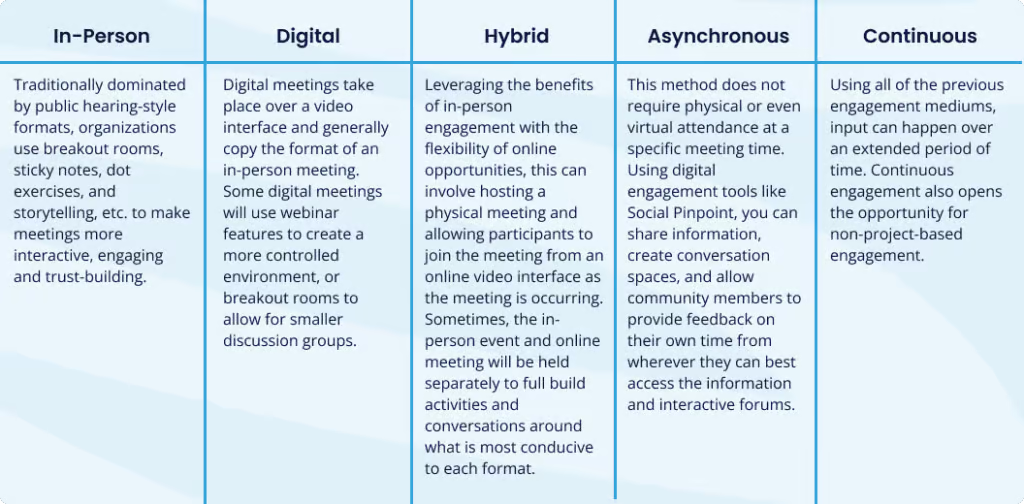
Engage Pittsburgh
EngagePGH is an online engagement portal oriented to the public, where stakeholders can explore City planning and policy projects, learn about past and upcoming work, and provide input in efficient and innovative ways. The platform meets and exceeds ADA-accessibility guidelines (WCAG 2.0), and enables a more robust and transparent feedback loop for stakeholders. Users experience more transparency and predictability with projects, and can engage on their own time, with ease, and with access to any smart-enabled device.
- Six different City Departments and the Mayor’s Office use the portal and have published 145 projects in the last three years
- Residents and stakeholders know that they can come to EngagePGH for specific projects, or to find engagement opportunities for various topics and locations of interest
- Since July 2020, EngagePGH has been viewed over 435,000 times by more than 172,000 individuals (the population of Pittsburgh is 300,000)
- In 2022 alone, over 4,230 people responded to surveys, interactive maps, and visioning exercises, leaving over 6,500 comments
- Engagers came back for more– over a third of all site visitors participated more than once, and about 18% of all comments came from people who were also registered on the site (total registered: 3,000)
A Pittsburgh Example: Pre- and Post-Pandemic
In the summer of 2019, the City of Pittsburgh hosted two in-person open houses about urban design in the Oakland neighborhood. Each session lasted three hours (10-1 pm and 5-8 pm), requiring a great deal of staff time in preparing and facilitating the open house events. In total, 120 people attended these open houses, which were broadly advertised and centrally located, with only 44 completing surveys.
Fast forward to the fall of 2020, in the height of the COVID-19 pandemic, the City of Pittsburgh hosted a two-month, virtual open house for the Oakland Plan. This open house received 2,475 unique visitors, 256 unique contributors, 785 individual contributions, and 121 new followers. Purely from a staff capacity perspective, this virtual, passive engagement reached a significantly larger audience with less personnel hours.
Top visited projects on EngagePGH during project period (July ‘20-March ‘21)
Lessons Learned in Digital+ Engagement
We need to adjust our strategies for key drivers of equitable engagement for digital settings.
Data is powerful but hard to use.
There are some cool, innovative opportunities with digital+ engagement!
We can use digital tools to move away from only project-specific engagement
We need to adjust our strategies for key drivers of equitable engagement in digital+ settings.
- Psychological Availability: having the capacity to engage
- Psychological Safety: having the freedom and safety to engage
- Psychological Meaningfulness: having a reason to engage
Having the Capacity to Engage
Acknowledging that for many people, there are more urgent, difficult needs in their daily life than providing feedback on a City project, despite how theoretically connected they may be to the work. It is imperative for project managers to do their best at utilizing existing community forums, events, and communication channels to reduce the number of meetings or interfaces someone is being asked to engage with in order to shape the projects in their neighborhood or interest area. Use stakeholder mapping to understand which tools will reach which audiences and identifying where efforts can be combined, and where you need to have more targeted outreach. This is not an either/or situation — you will need to use a variety of engagement tools to reach your audience. In Pittsburgh, City Planning staff translated all presentation and survey materials so the Spanish-speaking residents in a particular neighborhood could engage to the same degree as English-speaking residents.
Having the Freedom and Safety to Engage
This should be the baseline for all practitioners, period. Digital and hybrid mediums provide an alternative when in-person meetings cannot be a physically or psychologically safe space. For example, in Pittsburgh’s Hill District neighborhood, there are many competing voices and complex power dynamics. Where in-person and video meetings are great tools, not all participants felt safe sharing their voices, so EngagePGH offered an alternative where their voices would have equal value without the social pressure.
Having a Reason to Engage
EngagePGH allows site visitors to search by project, or by geography, categories, and keywords that are most meaningful to them as individuals. Bringing in new voices through digital tools that let people choose what they want to engage with, and create structures that don’t require stakeholders to be experts on their own government to find input opportunities. Make it easy, and center their narrative as the position of power, while identifying the direct connection between their feedback and the specific decisions it might influence.
Data is powerful, but hard to use.
- GARE Equity Toolkit (page 8) emphasizes a data audit of your stakeholders before starting a project. Collecting non-project-based data can help with this.
- Use digital engagement tools that automatically show results to easily compare/contrast between input and final decisions.
- Use data to see if your strategies are working to “meet people where they are”.
- Combine data collected from in-person & digital mediums. One is not more valuable than the other.
